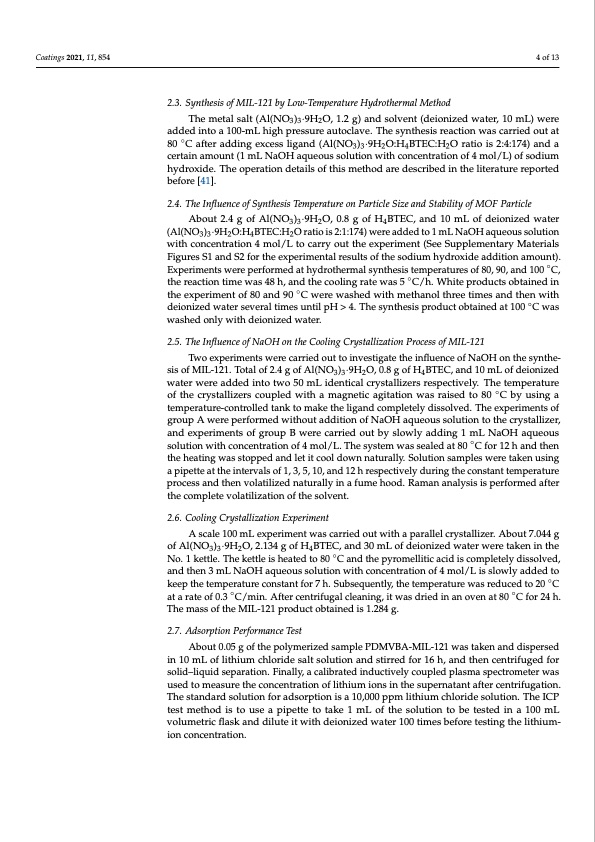
PDF Publication Title:
Text from PDF Page: 004
Coatings 2021, 11, 854 4 of 13 2.3. Synthesis of MIL-121 by Low-Temperature Hydrothermal Method The metal salt (Al(NO3)3·9H2O, 1.2 g) and solvent (deionized water, 10 mL) were added into a 100-mL high pressure autoclave. The synthesis reaction was carried out at 80 ◦C after adding excess ligand (Al(NO3)3·9H2O:H4BTEC:H2O ratio is 2:4:174) and a certain amount (1 mL NaOH aqueous solution with concentration of 4 mol/L) of sodium hydroxide. The operation details of this method are described in the literature reported before [41]. 2.4. The Influence of Synthesis Temperature on Particle Size and Stability of MOF Particle About 2.4 g of Al(NO3)3·9H2O, 0.8 g of H4BTEC, and 10 mL of deionized water (Al(NO3)3·9H2O:H4BTEC:H2O ratio is 2:1:174) were added to 1 mL NaOH aqueous solution with concentration 4 mol/L to carry out the experiment (See Supplementary Materials Figures S1 and S2 for the experimental results of the sodium hydroxide addition amount). Experiments were performed at hydrothermal synthesis temperatures of 80, 90, and 100 ◦C, the reaction time was 48 h, and the cooling rate was 5 ◦C/h. White products obtained in the experiment of 80 and 90 ◦C were washed with methanol three times and then with deionized water several times until pH > 4. The synthesis product obtained at 100 ◦C was washed only with deionized water. 2.5. The Influence of NaOH on the Cooling Crystallization Process of MIL-121 Two experiments were carried out to investigate the influence of NaOH on the synthe- sis of MIL-121. Total of 2.4 g of Al(NO3)3·9H2O, 0.8 g of H4BTEC, and 10 mL of deionized water were added into two 50 mL identical crystallizers respectively. The temperature of the crystallizers coupled with a magnetic agitation was raised to 80 ◦C by using a temperature-controlled tank to make the ligand completely dissolved. The experiments of group A were performed without addition of NaOH aqueous solution to the crystallizer, and experiments of group B were carried out by slowly adding 1 mL NaOH aqueous solution with concentration of 4 mol/L. The system was sealed at 80 ◦C for 12 h and then the heating was stopped and let it cool down naturally. Solution samples were taken using a pipette at the intervals of 1, 3, 5, 10, and 12 h respectively during the constant temperature process and then volatilized naturally in a fume hood. Raman analysis is performed after the complete volatilization of the solvent. 2.6. Cooling Crystallization Experiment A scale 100 mL experiment was carried out with a parallel crystallizer. About 7.044 g of Al(NO3)3·9H2O, 2.134 g of H4BTEC, and 30 mL of deionized water were taken in the No. 1 kettle. The kettle is heated to 80 ◦C and the pyromellitic acid is completely dissolved, and then 3 mL NaOH aqueous solution with concentration of 4 mol/L is slowly added to keep the temperature constant for 7 h. Subsequently, the temperature was reduced to 20 ◦C at a rate of 0.3 ◦C/min. After centrifugal cleaning, it was dried in an oven at 80 ◦C for 24 h. The mass of the MIL-121 product obtained is 1.284 g. 2.7. Adsorption Performance Test About 0.05 g of the polymerized sample PDMVBA-MIL-121 was taken and dispersed in 10 mL of lithium chloride salt solution and stirred for 16 h, and then centrifuged for solid–liquid separation. Finally, a calibrated inductively coupled plasma spectrometer was used to measure the concentration of lithium ions in the supernatant after centrifugation. The standard solution for adsorption is a 10,000 ppm lithium chloride solution. The ICP test method is to use a pipette to take 1 mL of the solution to be tested in a 100 mL volumetric flask and dilute it with deionized water 100 times before testing the lithium- ion concentration.PDF Image | Small Particles for Lithium Adsorption from Brine

PDF Search Title:
Small Particles for Lithium Adsorption from BrineOriginal File Name Searched:
coatings-11-00854-v2.pdfDIY PDF Search: Google It | Yahoo | Bing
Product and Development Focus for Infinity Turbine
ORC Waste Heat Turbine and ORC System Build Plans: All turbine plans are $10,000 each. This allows you to build a system and then consider licensing for production after you have completed and tested a unit.Redox Flow Battery Technology: With the advent of the new USA tax credits for producing and selling batteries ($35/kW) we are focussing on a simple flow battery using shipping containers as the modular electrolyte storage units with tax credits up to $140,000 per system. Our main focus is on the salt battery. This battery can be used for both thermal and electrical storage applications. We call it the Cogeneration Battery or Cogen Battery. One project is converting salt (brine) based water conditioners to simultaneously produce power. In addition, there are many opportunities to extract Lithium from brine (salt lakes, groundwater, and producer water).Salt water or brine are huge sources for lithium. Most of the worlds lithium is acquired from a brine source. It's even in seawater in a low concentration. Brine is also a byproduct of huge powerplants, which can now use that as an electrolyte and a huge flow battery (which allows storage at the source).We welcome any business and equipment inquiries, as well as licensing our turbines for manufacturing.| CONTACT TEL: 608-238-6001 Email: greg@infinityturbine.com | RSS | AMP |